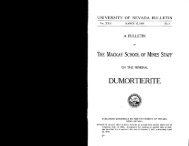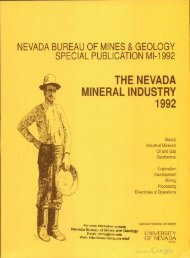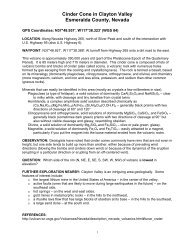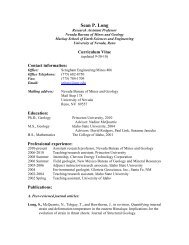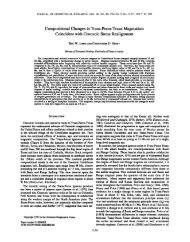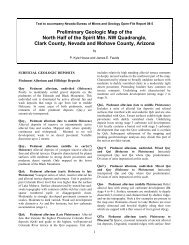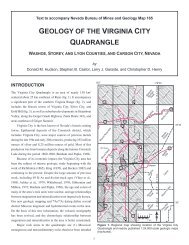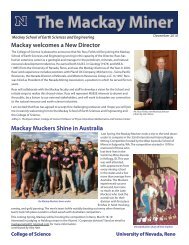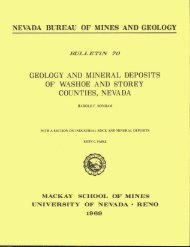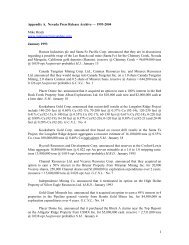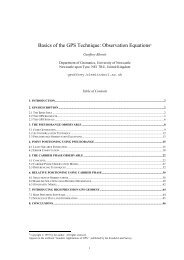Nevada Bureau of Mines and Geology - University of Nevada, Reno
Nevada Bureau of Mines and Geology - University of Nevada, Reno
Nevada Bureau of Mines and Geology - University of Nevada, Reno
Create successful ePaper yourself
Turn your PDF publications into a flip-book with our unique Google optimized e-Paper software.
LOCATION<br />
BLUE MOUNTAIN AREA<br />
(Ten Mile District)<br />
The Blue Mountain area lies approximately 18 miles west <strong>of</strong> Winnemucca<br />
<strong>and</strong> to the immediate north <strong>of</strong> the road that runs between Winnemucca <strong>and</strong><br />
Jungo. It is located on portions <strong>of</strong> the Rose Creek, Pronto, Gaskell, <strong>and</strong><br />
Mormon Dan Butte 7 1/2 minute topographic quadrangle maps, with the bulk<br />
<strong>of</strong> it on the Pronto quadrangle.<br />
HISTORY<br />
Nothing could be found in the literature on the history <strong>of</strong> the mine<br />
workings at Blue Mountain. There are only two areas in which work has been<br />
done. One lies on the south <strong>and</strong> east flank <strong>of</strong> the mountain. From all<br />
appearences these workings may date back as far as the 19301s(?). The<br />
second area <strong>of</strong> workings is located on the west-northwest flank <strong>of</strong> the<br />
mountain. Work here originally(?) consisted <strong>of</strong> mainly one shaft which has<br />
been wiped out from later, overlying exploration work. The most extensive<br />
workings are in <strong>and</strong> about the Atlas mine area. Individual workings here<br />
are quite small but they are spread over an area <strong>of</strong> approximately one mile<br />
in length (north-south) by approximately 1/2 mile in width.<br />
GEOLOGIC SETTING<br />
Blue Mountain is composed essentially <strong>of</strong> two formations separated by<br />
a thrust fault, one <strong>of</strong> which has been intruded by a gabbro. The western<br />
third <strong>of</strong> the mountain is composed <strong>of</strong> an un-named formation <strong>of</strong><br />
Triassic-Jurassic age. It is made up <strong>of</strong> phyllite, slate, fine-grained<br />
quartzite, <strong>and</strong> limestone. Towards the south-southeast edge <strong>of</strong> this<br />
formation is a gabbro intrusive which covers approximately one square<br />
mile. To the east <strong>of</strong> these two units <strong>and</strong> making up approximately<br />
two-thirds <strong>of</strong> the mountain is the Triassic Raspberry formation which was<br />
first described by Ferguson et. al. This formation is composed <strong>of</strong> gray,<br />
black, buff or green colored slate, which locally can be phyllitic;<br />
limestone lenses with limestone conglomerate in the lower portions <strong>of</strong> the<br />
formation <strong>and</strong> quartzite lenses varying from a few inches in thickness up<br />
to a 100 feet in thickness. The contact between these two largest units is<br />
a thrust fault (as mapped by Willden). It runs from the north end <strong>of</strong> the<br />
mountain to the south end <strong>and</strong> puts the younger metasediment formation over<br />
the older Raspberry formation. Two other, much smaller, areas <strong>of</strong> outcrop<br />
are found on the mountain, neither <strong>of</strong> which exceeds 2 square miles in<br />
areal extent. One <strong>of</strong> these is a quartzite <strong>and</strong> mudstone unit which crops<br />
out on the southeast flank <strong>of</strong> the mountain. It is Triassic in age <strong>and</strong><br />
shown by Willden to be somewhat older than the Raspberry formation. It is<br />
in normal sedimentary contact with the Raspberry formation, although the<br />
contact is mapped as approximately located or inferred. The second small<br />
unit outcrops on the far east edge <strong>of</strong> the mountain <strong>and</strong> extends beyond what<br />
the writer considers as Blue Mountain proper. These rocks consist <strong>of</strong><br />
basalts <strong>and</strong> <strong>and</strong>esites.<br />
Blue Mountain Area - 1



